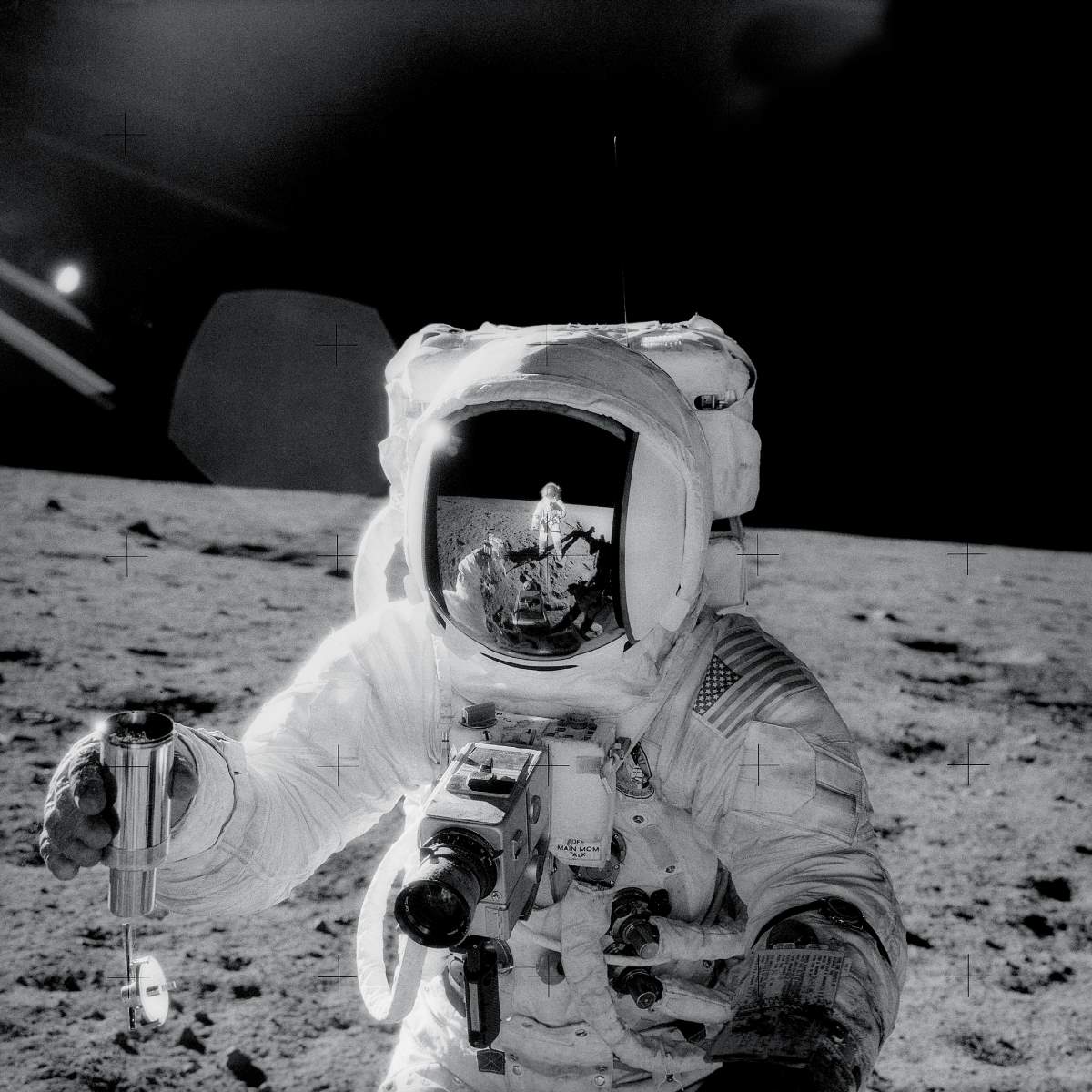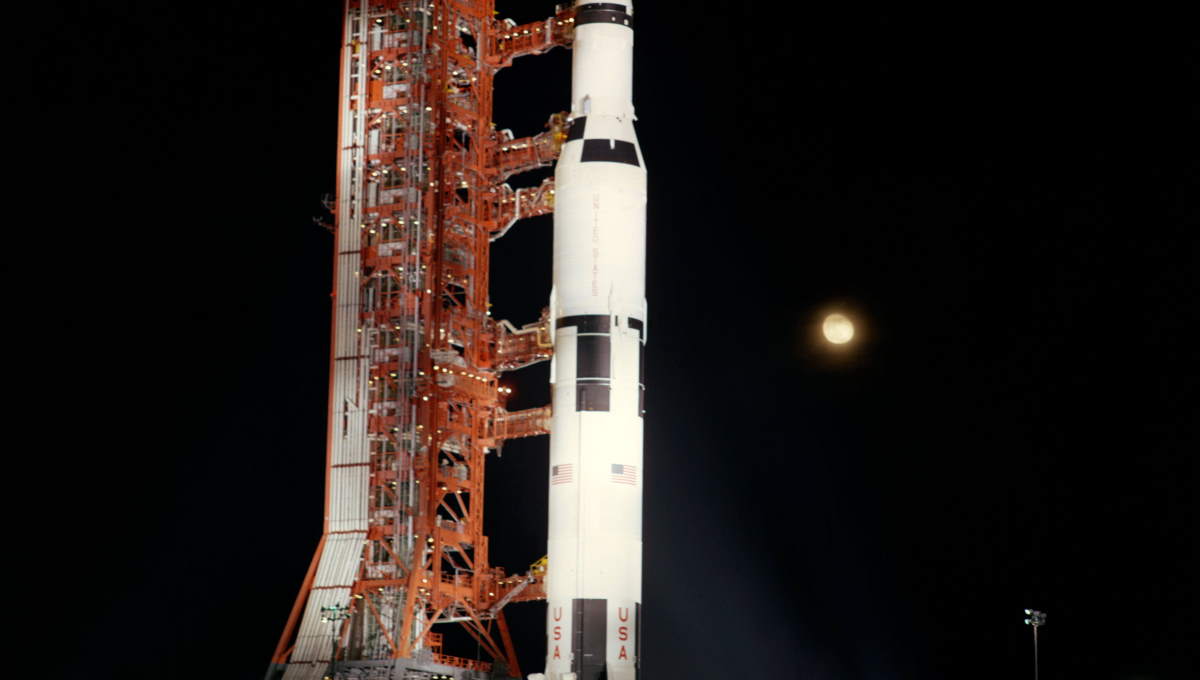NASA has published a beautiful photo of Apollo 12 at the launch pad 39A at the Kennedy Space Center Launch Complex 39. This historic image, taken on October 28, 1969 (50 years ago) frames the Apollo 12 spacecraft atop the mighty Saturn V rocket and its destination, the Moon, in a single photo.

Apollo 12
Launched on November 14, 1969, and landed on the Moon on November 19, 1969, Apollo 12 was the sixth crewed flight in the U.S.’ Apollo program and the second to land on the Moon, just five months after Apollo 11.
The crew was: Charles (Pete) Conrad, Jr., the commander; Richard F. Gordon, the command module pilot; and Alan L. Bean, the lunar module pilot.
Mission objectives included a series of lunar exploration tasks as well as the deployment of the Apollo Lunar Surface Experiments Package which was left on the Moon’s surface to gather data.
Other Apollo 12 objectives included a selenological inspection; surveys and samplings in landing areas; development of techniques for precision-landing capabilities; further evaluations of the human capability to work in the lunar environment for a prolonged period of time; deployment and retrieval of other scientific experiments; and photography of candidate exploration sites for future missions.
The astronauts also were to retrieve portions of the Surveyor III robotic probe, which had soft-landed on the moon April 20, 1967, to carry a surface-soil sampling-scoop, a short distance from the selected landing site of Apollo 12.

Mission Commander Charles Conrad and the lunar module pilot Alan Bean landed on the Moon with Lunar Module Intrepid on November 19. Gordon remained with the Command and Service Modules (CSM) “Yankee Clipper” in lunar orbit.
Their landing site was within walking distance of the site of Surveyor 3, as planned.
Conrad and Bean carried the first color television camera to the lunar surface, but Bean accidentally pointed it to the sun. As a result, the camera got destroyed and the transmission was lost.
On one of two moonwalks, they visited Surveyor 3 and removed some parts for return to Earth (see the video below).
On November 20, 1969, Intrepid lifted off from the Moon and docked with the command module, which then, after completing its 45th lunar orbit, traveled back to Earth.
The return flight was uneventful. Apollo 12 splashed down at 2:58 p.m. (CST), on November 24, 1969, near American Samoa. They were picked up by helicopter and flown to the prime recovery ship, USS Hornet.
Video: The Incredible Journey of Apollo 12
The transcription of the video above:
It’s the ultimate buddy movie, with two astronauts hitting the road and landing on the moon. Earth. November 14, 1969. Three astronauts, with spacesuits, food, water, and a battery of scientific and communications equipment, prepared to fly to the moon. Thousands gathered at the Kennedy Space Center in Florida, including President and Mrs. Richard Nixon, to witness the historic launch. It was raining that day, but that was no cause for delay. The ship that would carry them into space was designed to launch in any weather.
But how would it respond to a powerful electrical storm now gathering above the launchpad? That was just the beginning of the incredible journey of Apollo 12.
With three astronauts fastened into their seats, the countdown proceeded. Astronaut and Mission Commander Pete Conrad would say later: “The flight was extremely normal, for the first 36 seconds.” The five Rocketdyne F-1 engines of the Saturn 5’s huge first stage were designed to burn through 5 million pounds of liquid oxygen in just two and a half minutes and to send the spacecraft up 67 kilometers above the Atlantic Ocean.

Related: Saturn V Rocket (Documentary)
When it reached an altitude of 2,000 meters (6,500 feet), something unexpected happened. Racing through the stormy environment, the rocket generated a lightning bolt that traveled down its highly conductive exhaust trail.
Another bolt hit 16 seconds later. All of the spacecraft’s circuit breakers shut off. The tracking system was lost. A young flight controller in Houston, Texas instructed astronaut Alan Bean on how to turn on an auxiliary power system. The mission was back on track. Once in Earth orbit, all systems appeared to check out, and flight control officials gave the crew the green light to leave Earth.
The astronauts were not told of concern that the lighting strikes had damaged the pyrotechnic system used to deploy the parachutes that would ease them back through the Earth’s atmosphere. If that system failed, the astronauts would not return alive.
This mission would have its share of perils, not unlike those faced by a long line of past explorers, whose courage and restless spirit propelled them into the unknown. This one, however, was backed by years of technology development, test flights, astronaut training, and the largest support team back home that any mission ever had.
But hundreds of thousands of kilometers out in space the three astronauts were pretty much on their own. What made Apollo 12 unique was the friendship and chemistry of its crew. Conrad, Bean, and Richard Gordon were all Navy men. Working and training together on the Gemini program, they had gained each other’s respect and trust.

Now, hurtling across more than 400,000 kilometers (about 250,000 miles) to the Moon, they prepared to fulfill the mission’s goals. One was to set up a scientific station designed to record seismic, atmospheric, and solar data.
Another was to visit an unmanned lunar probe called Surveyor III that had landed there two and a half years before. The idea was to bring back apart to study the effect of the lunar environment.
A third goal was to improve on the landing of Apollo 11 just 5 months before. Dropping down over a region called the Sea of Tranquility, lunar module pilot Neil Armstrong found himself heading straight for a crater full of boulders. He had to fly over the planned landing site and find a new one. Now kilometers beyond the target, the lander, called Eagle, was literally running out of gas.
With less than 30 seconds of fuel left, Neil Armstrong and Buzz Aldrin finally touched down on a landscape obscured by dust stirred up by the vehicle’s thrusters. Future astronauts would have to be able to make precision landings at locations dictated by science. That meant they would have to touch down on landscapes filled with all kinds of rocks and craters.
For Apollo 12, the science pointed to a region known as the Ocean of Storms, some 2000 kilometers (1,243 miles) from where the Eagle had landed. Here, the landscape is dark from lava that cooled to form its flat expanse billions of years ago.
Sources
- Apollo 12 on Wikipedia
- Surveyor 3 on Wikipedia
- Apollo 12 on NASA.gov
- Moon Landings: All-Time List [1966-2025] - February 2, 2025
- What Is Max-Q and Why Is It Important During Rocket Launches? - January 16, 2025
- Top 10 Tallest Rockets Ever Launched [2025 Update] - January 16, 2025

